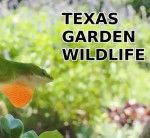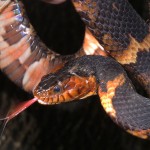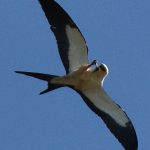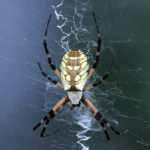September 2021
These days I make a real effort to incorporate our daily dog walk into my exercise routine. As a result the pups and I go a little further than we used to, and we walk a lot of laps around the local dog park. On some days we may invest as much as a couple of hours in the endeavor. To help pass the time, I invented a little game that I play every now and again. It’s called: Spot the Small, Camouflaged Critter in the Bushes While You Walk By at Full Speed.
Or, something like that.
The inspiration for the game came after I stumbled across a couple of praying mantis exoskeletons on the grass along our usual route. Mantises periodically shed their exoskeletons as they grow. The old, immutable exoskeletons can’t get bigger, so they have to be shed and left behind. The soft, elastic tissue underneath hardens a short time later to form a new, better fitting exoskeleton for the growing mantis.
Finding shed exoskeletons on the ground is a good indication that there is a healthy population of Praying mantises in the immediate area, but up until that point in time I had not noticed one. Based on where I found the skeletons, it seemed likely that the mantises were spending time in the Black Willow branches overhanging the trail. I began to wonder if I might be able to find a mantis or two if I kept an eye out.
Our route ordinarily takes us past a chain link fence that is overgrown with Ragweed, Johnson Grass, Horse Weed, and others. For much of the way overhanging Black Willow branches provide shade. It is along this quarter mile stretch that we play the game.
As we continued on our way, I began scanning the willows as we passed by, but did not have much success. When that approach came up empty, I moved my search down to the vegetation under the trees. That is when I first started noticing other little creatures. A tiny Green Tree Frog—one of my favorites—was the first critter I spotted, and I followed up by finding an entire menagerie of miniature wildlife as we continued along.
Last week, as the first, barely noticeable, hints of fall began to be felt, the micro-wildlife in this quaint little habitat began making more frequent appearances. It turns out that this section of fence line is actually teeming with little creatures—but that doesn’t mean they are easy to see. These critters use a mix of subtle colors to camouflage themselves. The pallet consists of various shades of greens, reds, blacks, and yellows—with some other colors thrown in for good measure. Their disguises are often quite effective, and you really have to be paying attention as you walk by in order to spot them. Here are just a few examples of what we found…
Green Tree Frog
Attractive Green Tree Frogs, with their beautiful metallic gold eyes, are numerous along this route, and can frequently be found perched on ragweed where they bask in the early morning sun. The majority are juvenile, first season frogs; most could sit on a finger nail with room to spare.
These frogs rely on their camouflage to keep them safe from predators. As a result, they are inclined to hold their positions and remain motionless when approached. If you are discreet and careful, it is possible to get a camera within just and inch or two of these frogs without spooking them.
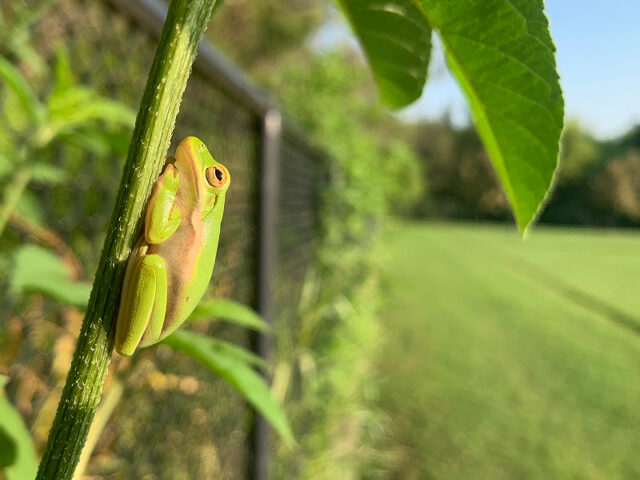

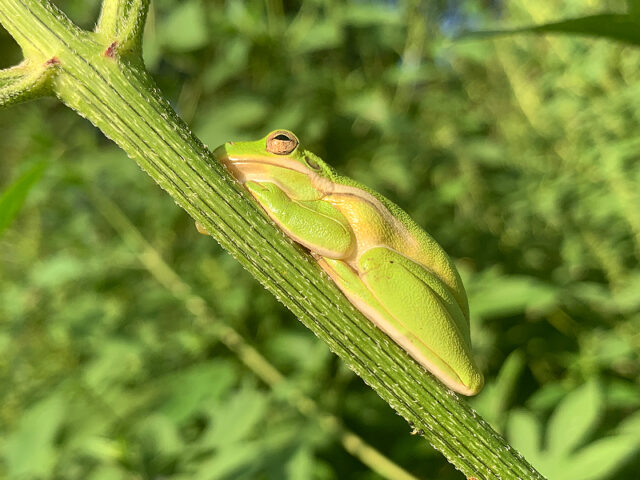

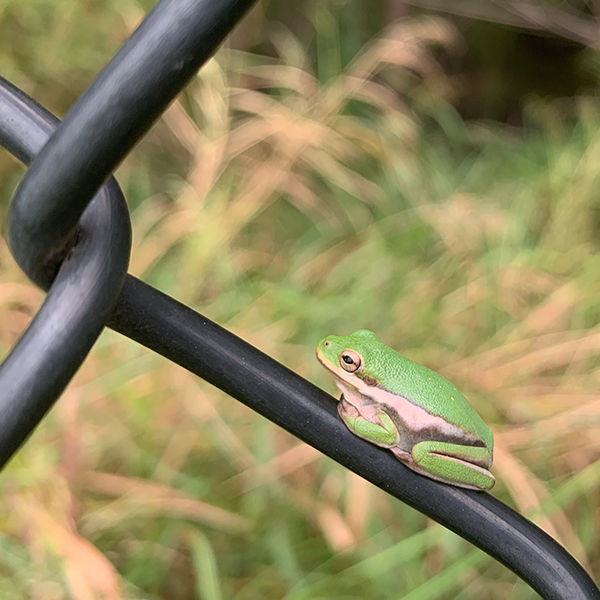

Rough Green Snake
Rough Green Snakes are particularly difficult to spot, unless they do you the favor of crawling out onto the fence itself. In vegetation, the Rough Green Snake’s form and color make it a near perfect stand in for a branch or vine. These snakes can absolutely vanish into the greenery growing up along this fence.
Over the course of the week we spotted several of these guys, each ranging in size from just around a foot long to well over two feet in length. See the pictures below…


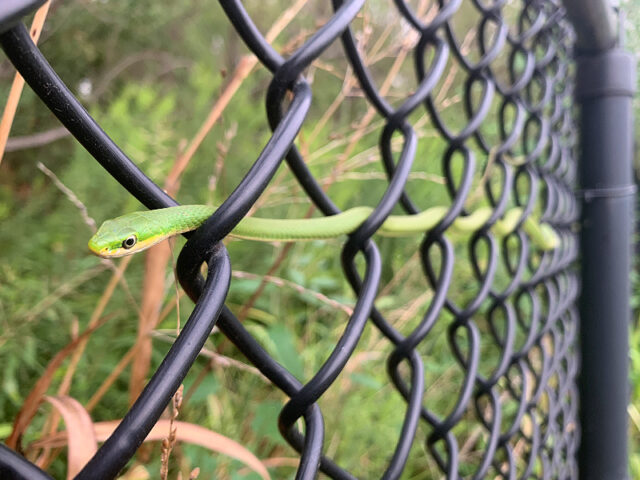
Green Anole
Green Anoles hold court on this fence as well. Many that we found were tiny hatchlings—just days old. Others have been here much longer, and continue to signal and jockey for territory and position with the other adult anoles.
Anoles are famous for their ability to change their color according to varying conditions and situations. In the following pictures you will see some lizards that are a rich emerald green, and others that are a dusty reddish-brown—or various transitional shades between the two.


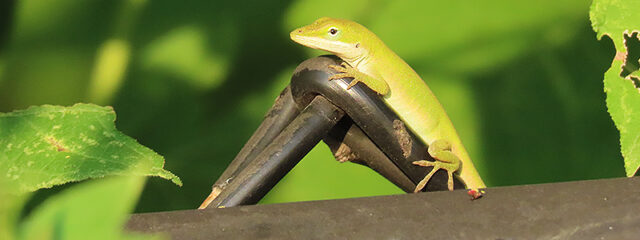
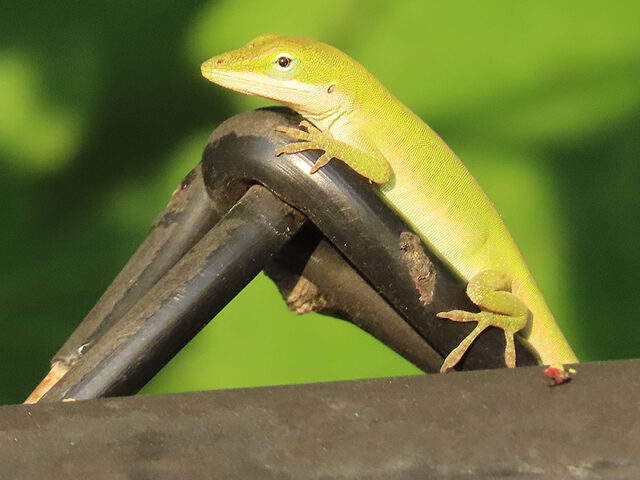

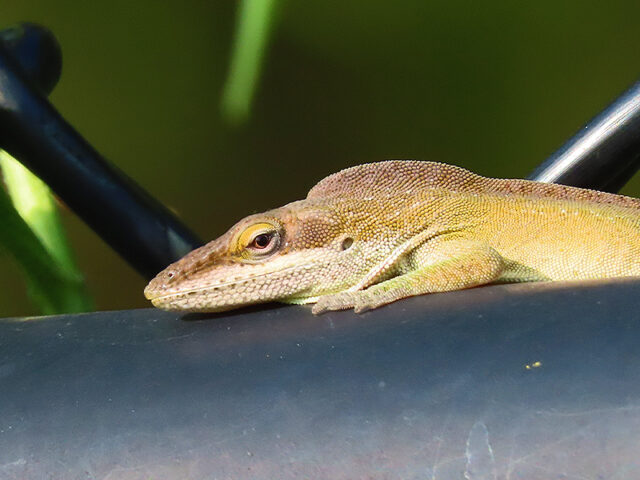
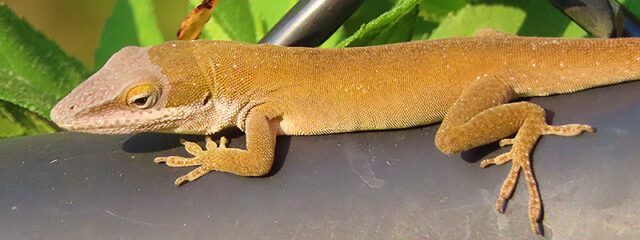

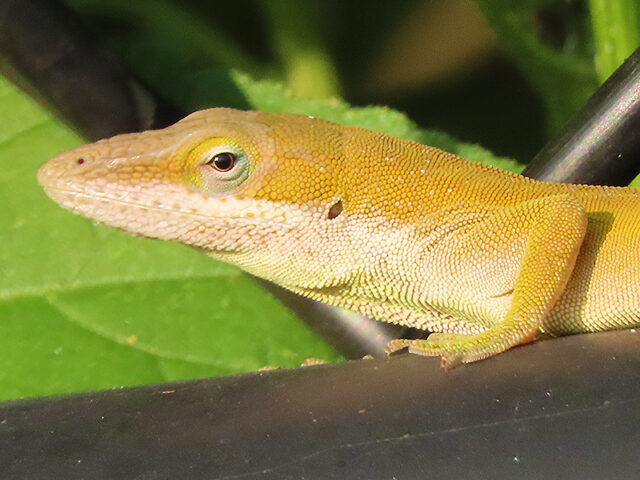
Insects and Spiders
As you might imagine, insects accounted for a good deal of the animal life we found along the fence. The colors they used for camouflage remained consistent, however—red, green, black, and yellow. This Black-legged Meadow Katydid is a fine example. Vivid green overall, with red highlights, and black legs. Also found with some regularity were Differential Grasshoppers, Wheel Bugs, Leaf-footed Bugs, Giant Robber Flies, and Black and Yellow Garden Spiders.


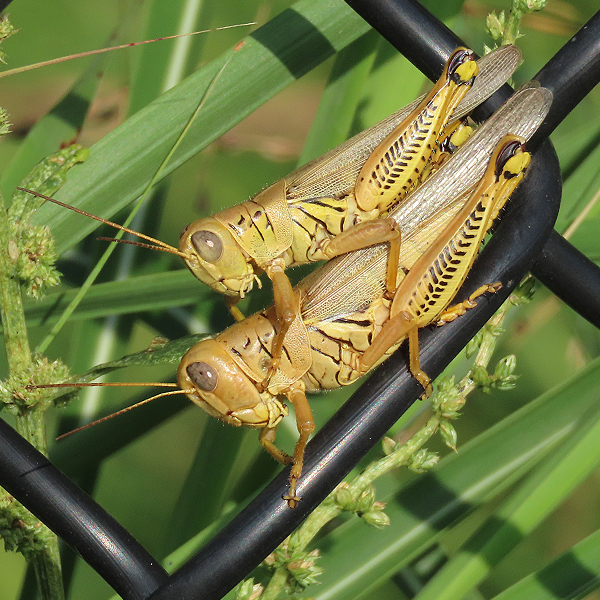
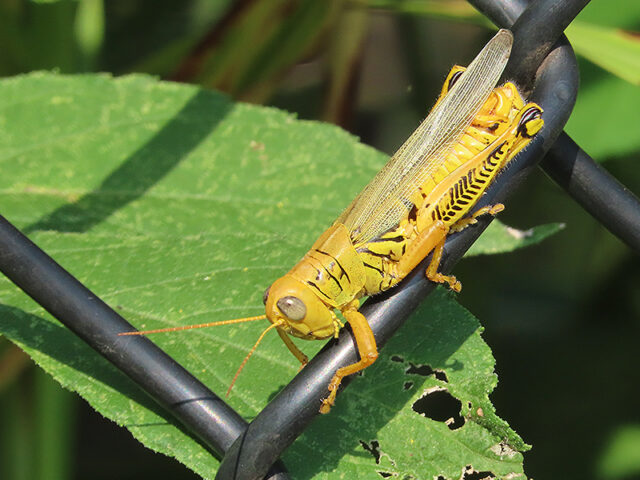




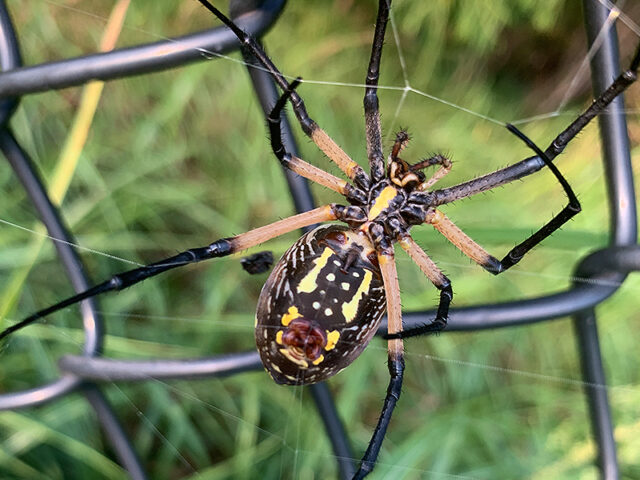

because of the intricate radial webs they construct
Western Ribbon Snake
Continuing with the theme of black and yellow, the next critter we found was the Western Ribbon Snake. We also found several of these snakes, each ranging in size from 1 foot to 2 feet in length. Some were observed as they hunted high in the ragweed, and others were found snaking across the lawn grass. In both cases, the yellow, white, and black striping worked as effective camouflage, especially when the snake was in the shade.


as they reach the snake’s head
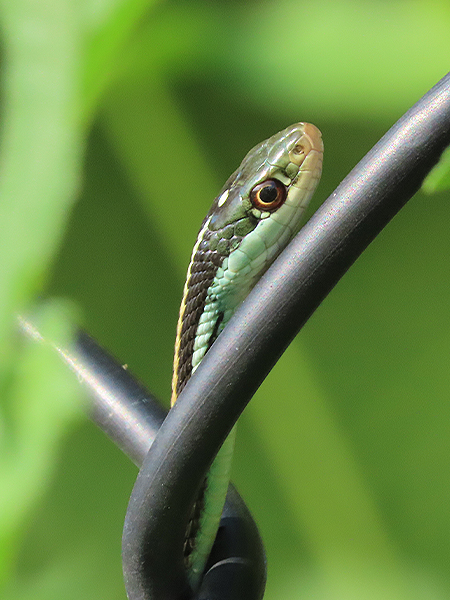
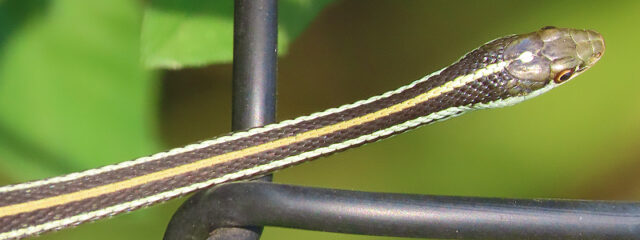
in a very straight line. The result was a convincing likeness of a blade of Johnson Grass
Red Swamp Crayfish
Red Swamp Crayfish typically live in warm, slow moving bodies of water. And, indeed, the park where we walk is surrounded by wetlands for much of the year. Ordinarily, the Texas heat usually dries it all up by mid-summer, and this year was no different. In places like this—where the water is intermittent—these crayfish can survive up to 4 months in dry conditions by retreating into burrows dug down to the water table.
Crayfish have gills and need water to breath, but if the temperatures are not too warm, and there is plenty of moisture from sprinklers, dew, or rain, these intrepid crustaceans will venture out onto the land. Along the fence line, crayfish will sometimes emerge from their burrows and on to the lawn early in the morning, if the irrigation system has done a good job of saturating the grass.
Red Swamp Crayfish have an interesting reproductive strategy. In order to protect their growing offspring, female Red Swamp Crayfish carry their young around with them. Juvenile crayfish cling to the underside of their mother’s tail until they are old enough to fend for themselves. We found one big female in this state and took a few pictures to share. See below…
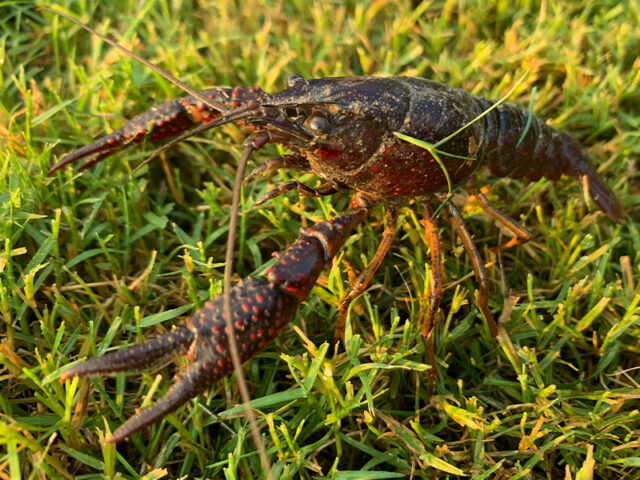


clinging to the underside of her tail

Southern Leopard Frog
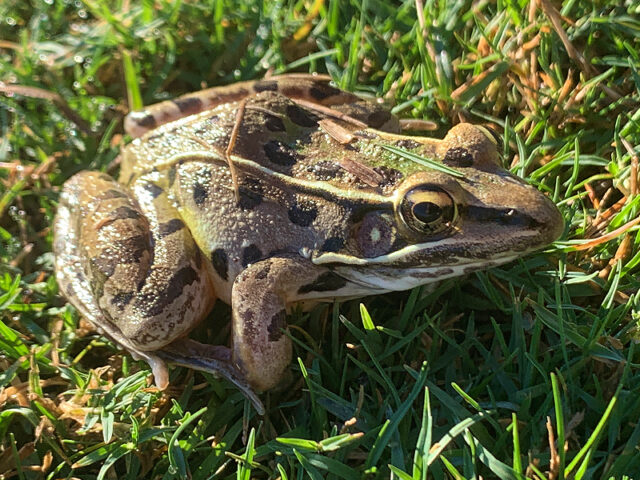
Carolina Mantis
Ironically, it was just today that I finally stumbled across a couple of examples of the praying mantises that originally inspired this game. I found two on the same day; both in close proximity to each other. One was green and the other was brown. I learned later that Carolina Mantis adjust their coloring at molting time in accordance with certain environmental conditions. Various shades of green and brown are possible. Both of the mantises I found are female, and will likely be laying eggs soon.
Praying Mantis lay their eggs encapsulated inside a protective structure known as an ootheca. Up to 50 eggs will overwinter inside and then hatch out as nymphs in the spring.


UPDATE: September 13, 2021
I took these pictures early this morning, and thought they would make a nice addition to this post. These photographs show a female Carolina Mantis laying her egg—in other words, producing her ootheca. This is what it looks like!




